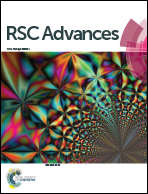Complete dissipation of 2,4,6-trinitrotoluene by in-vessel composting†
Abstract
We demonstrate complete removal of 2,4,6-trinitrotoluene (TNT) in 15 days using an in-vessel composting system, which is amended with TNT-degrading bacteria strains. A mixture of TNT, food waste, manure, wood chips, soil and TNT-degrading bacteria consortium are co-composted for 15 days in an aerobic environment. Variations in the TNT degradation rates are assessed when composting reactors are operated at different carbon/nitrogen ratios (C/N), aeration rates, TNT concentrations and TNT-degrading bacteria inoculum loads. Changes in TNT concentrations are measured using high performance liquid chromatography, and C/N are determined using elemental analysis every 5 days. Temperature and moisture of the system are measured every 6 hours. Optimum TNT degradation performance is achieved by combining C/N of 20/1 and a 5 L min−1 aeration rate. Complete removal is achieved for TNT concentrations of 2, 10, and 100 g kg−1 in 15 days by the help of Citrobacter murliniae STE10, Achromobacter spanius STE11, Kluyvera cryocrescens STE12, and Enterobacter amnigenus STE13 bacteria strains. The final products of composting are used to cultivate four different plant seedlings for 10 weeks and showed no toxic effect, which is promising for the potential agricultural use of TNT-contaminated lands after remediation.


 Please wait while we load your content...
Please wait while we load your content...